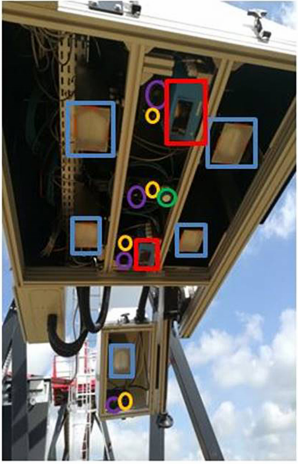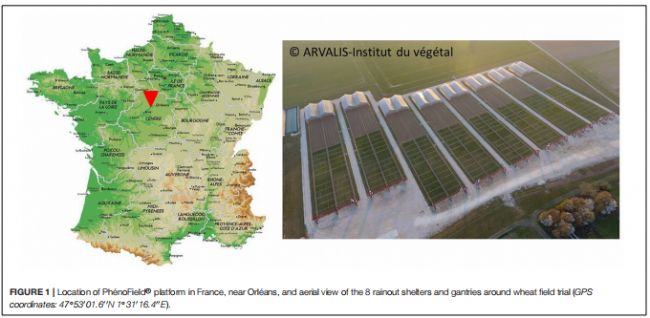室外植物表型成像平台在作物行间距对小麦品质影响实验上的应用
最近,来自法国Hiphen公司、法国农业科学院以及ARVALIS的科学家发表了室外表型研究新文章,题为Architectural Response of Wheat Cultivars to Row Spacing Reveals Altered Perception of Plant Density的文章,就培育地的作物行间距对小麦品质结构影响做了深入探索。系统使用了联合构建的PhénoField 室外植物表型成像平台。
 文章摘要请看下文。博普特是法国农业科学院、Hiphen公司开发的室外植物表型成像系统中国区总代理。
文章摘要请看下文。博普特是法国农业科学院、Hiphen公司开发的室外植物表型成像系统中国区总代理。


Architectural Response of Wheat Cultivars to Row Spacing Reveals Altered Perception of Plant Density
Mariem Abichou1 , Benoit de Solan2,3 and Bruno Andrieu1*
1 UMR ECOSYS, INRA, AgroParisTech, Université Paris-Saclay, Thiverval-Grignon, France, 2 ARVALIS – Institut du Végétal, Paris, France, 3 UMR EMMAH, INRA, Avignon, France
In order to evaluate the impact of water deficit in field conditions, researchers or breeders must set up large experiment networks in very restrictive field environments. Experience shows that half of the field trials are not relevant because of climatic conditions that do not allow the stress scenario to be tested. The PhénoField® platform is the first field based infrastructure in the European Union to ensure protection against rainfall for a large number of plots, coupled with the non-invasive acquisition of crops’ phenotype. In this paper, we will highlight the PhénoField® production capability using data from 2017-wheat trial. The innovative approach of the PhénoField® platform consists in the use of automatic irrigating rainout shelters coupled with high throughput field phenotyping to complete conventional phenotyping and micrometeorological densified measurements. Firstly, to test various abiotic stresses, automatic mobile rainout shelters allow fine management of fertilization or irrigation by driving daily the intensity and period of the application of the desired limiting factor on the evaluated crop. This management is based on micro-meteorological measurements coupled with a simulation of a carbon, water and nitrogen crop budget. Furthermore, as high-throughput plant-phenotyping under controlled conditions is well advanced, comparable evaluation in field conditions is enabled through phenotyping gantries equipped with various optical sensors. This approach, giving access to either similar or innovative variables compared manual measurements, is moreover distinguished by its capacity for dynamic analysis. Thus, the interactions between genotypes and the environment can be deciphered and better detailed since this gives access not only to the environmental data but also to plant responses to limiting hydric and nitrogen conditions. Further data analyses provide access to the curve parameters of various indicator kinetics, all the more integrative and relevant of plant behavior under stressful conditions. All these specificities of the PhénoField® platform open the way to the improvement of various categories of crop models, the fine characterization of variety behavior throughout the growth cycle and the evaluation of particular sensors better suited to a specific research question.



Architectural Response of Wheat Cultivars to Row Spacing Reveals Altered Perception of Plant Density
Mariem Abichou1 , Benoit de Solan2,3 and Bruno Andrieu1*
1 UMR ECOSYS, INRA, AgroParisTech, Université Paris-Saclay, Thiverval-Grignon, France, 2 ARVALIS – Institut du Végétal, Paris, France, 3 UMR EMMAH, INRA, Avignon, France
In order to evaluate the impact of water deficit in field conditions, researchers or breeders must set up large experiment networks in very restrictive field environments. Experience shows that half of the field trials are not relevant because of climatic conditions that do not allow the stress scenario to be tested. The PhénoField® platform is the first field based infrastructure in the European Union to ensure protection against rainfall for a large number of plots, coupled with the non-invasive acquisition of crops’ phenotype. In this paper, we will highlight the PhénoField® production capability using data from 2017-wheat trial. The innovative approach of the PhénoField® platform consists in the use of automatic irrigating rainout shelters coupled with high throughput field phenotyping to complete conventional phenotyping and micrometeorological densified measurements. Firstly, to test various abiotic stresses, automatic mobile rainout shelters allow fine management of fertilization or irrigation by driving daily the intensity and period of the application of the desired limiting factor on the evaluated crop. This management is based on micro-meteorological measurements coupled with a simulation of a carbon, water and nitrogen crop budget. Furthermore, as high-throughput plant-phenotyping under controlled conditions is well advanced, comparable evaluation in field conditions is enabled through phenotyping gantries equipped with various optical sensors. This approach, giving access to either similar or innovative variables compared manual measurements, is moreover distinguished by its capacity for dynamic analysis. Thus, the interactions between genotypes and the environment can be deciphered and better detailed since this gives access not only to the environmental data but also to plant responses to limiting hydric and nitrogen conditions. Further data analyses provide access to the curve parameters of various indicator kinetics, all the more integrative and relevant of plant behavior under stressful conditions. All these specificities of the PhénoField® platform open the way to the improvement of various categories of crop models, the fine characterization of variety behavior throughout the growth cycle and the evaluation of particular sensors better suited to a specific research question.





